IAC News
IAC News No.24, October 2014
Japan Society of Civil Engineers International Activities Center Oct. 1, 2014 IAC News No.24
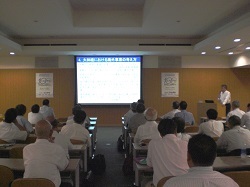 IAC Japanese Civil Engineers the Global Leaders Symposium Series No.2 |
INSIDE JSCE series3 Activities of Concrete Committee
In September 1928, the Concrete Research Committee of the Japan Society of Civil Engineers (JSCE) was established to develop the first Japanese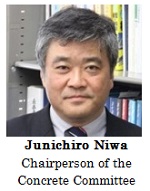 code for concrete structures. The committee later evolved into today’s JSCE Concrete Committee. Since publication of the first edition in 1931, the JSCE’s “Standard Specifications for Concrete Structures” has been revised multiple times and is widely used in Japan.
code for concrete structures. The committee later evolved into today’s JSCE Concrete Committee. Since publication of the first edition in 1931, the JSCE’s “Standard Specifications for Concrete Structures” has been revised multiple times and is widely used in Japan.
In the 1986 edition of the Standard Specifications, the basic design method was updated from the allowable stress design method to the limit state design method. In 2001, a Maintenance section was included in the Standard Specifications, and the 2002 edition shifted from specification-based design to performance-based design.
The Standard Specifications outlines a concrete engineering system and acts as a foundation for other Japanese codes. Revision of the Standard Specifications remains one of the main activities of the Concrete Committee, with a subcommittee on revision of the Standard Specifications for Concrete Structures overseeing the revision work.
Other activities of the Concrete Committee include the establishment of subcommittees for research on selected themes; the organization of lecture meetings, seminars and symposia; the development of recommendations; the standardization of concrete materials; and the unification of terms and symbols.
Draft recommendations based on subcommittees’ research outcomes have been published as "Concrete Library" since 1961. Concrete Library No. 143 is the latest issue (as of September 2014). In addition, important topics and research results on concrete technology that require investigation in the future are put together and published as the “Concrete Engineering Series"; this has been published since 1992 and Concrete Engineering Series No. 105 is the latest issue (as of September 2014).
International activities are also one of the JSCE Concrete Committee’s major interests. The Subcommittee on International Activities disseminates information about the Concrete Committee and Japanese concrete technology to the world. An English-language newsletter (Fig. 1) is released four times a year and sent to over 2000 readers around the globe. The contents of the newsletter summarize newly released standards edited by the Concrete Committee, the activities of various subcommittees, summaries of excellent papers that receive JSCE awards, information on disasters in Japan, and so forth, while the New Year issue always features special articles on Japanese concrete technology. The Subcommittee on International Activities also organizes joint seminars (Table 1) with academic societies that have an agreement with JSCE in order to develop mutual understanding between the leaders of concrete engineering in other countries.
Recently, the Concrete Committee has also been working to promote use of the JSCE Standard Specifications for Concrete Structures in ASEAN countries. The specifications cover the latest technologies, such as methods of controlling early-age cracking for the quality assurance of concrete structures, pioneering standards for the maintenance of concrete structures, the latest technology for seismic design, and so forth. The Concrete Committee hopes that the use of the Standard Specifications and the latest technology in ASEAN countries will contribute to the construction of high quality concrete structures with reduced future maintenance costs.
The JSCE Standard Specifications for Concrete Structures has been revised to reflect developments in Japanese technology. In promoting the specifications outside Japan, therefore, it is necessary to consider the different cultures and environments of the various ASEAN countries. To this end, joint seminars have been held recently in ASEAN countries to introduce the standard specifications. Through these seminars and communications with engineers in the host countries, the Concrete Committee is working to boost recognition of the specifications and understand the needs of those countries. An English edition of the 2007 edition of the Standard Specifications was prepared for worldwide use, and is available for free download.
Strong, flexible, and sustainable structures are required to protect not only people in Japan but also people around the world from natural catastrophes, as well as from new types of disasters arising from climate change and other environmental issues. In order to help meet people's need for safety, the JSCE Concrete Committee will do its best to develop and disseminate Japan’s world-leading concrete technology.
 |
| Newsletter |
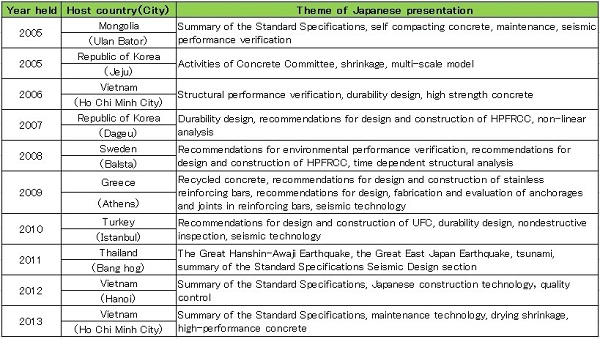 |
| Joint Semnar |
Participate report of 2014, Korea・Japan・Taiwan Joint Conference
Korea・Japan・Taiwan Joint Conference on Civil Engineering was held by KSCE Busan・Ulsan・Gyeongnam Section, JSCE Seibu Chapter and Taiwan Society & Public Work (TSPW) at Pukyong National University in Pusan, South Korea on August 29th, 2014.
The 1st Joint Seminar held in Kumamoto in 2012, co-hosted by the KSCE Pusan Section and JSCE Seibu Chapter, and the TSPW joined co-host those two societies this Joint Conference. The Seibu Branch held the Joint Conference as part of JSCE’s 100th Anniversary Celebration commemorative events.
In the conference, the civil engineering professionals and students of Japan, Korea and Taiwan made presentations on diverse fields from environment to disaster preparedness and prevention. Prof. Myung-Pil Shim the KSCE President and Emeritus Professor Toshimitsu Komatsu of Kyushu University delivered opening addresses, followed by the keynote lectures given by Prof. Koreyoshi Yamazaki, the Seibu Chapter President and Mr. Jong-Chool Lee the Pusan Section President. The conference was conducted in English the conference’s official language. Twenty members of the Seibu Chapter participated in the seminar, who were Prof. Yamazaki, Emeritus Professor Komatsu, 13 students and 5 leaders from Kyushu University, Kumamoto University and Miyazaki University. For those students it was the very first opportunity to discuss their research projects in English abroad. Many of them held their heads up high and spoke fluently; at the same time, some might have had a hard time discussing in their second language. They also received and responded to sharp questions and insightful comments from those professionals, which would give them useful clues to improve their studies and researches in the future, and they kept the conversational ball rolling nicely. That should have been a good experience for them. Dr. Higuchi an Kyoto University graduate came from Taiwan and gave a speech. His participation should have given the students motivation to excel in their academic and future professional endeavors. It should not be forgotten to mention that Mr. Kawamata Consul General, Consulate-General of Japan in Busan joined the conference.
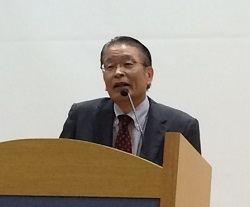 |
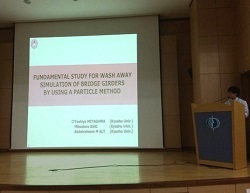 |
| Emeritus Prof. Komatsu of Kyushu University delivers an opening address. | A student member of JSCE Seibu Branch discusses his research project. |
The Joint Conference is one good example that international cooperation and technical exchange are developed even between sections. Promoting and developing the communication between JSCE’s regional chapters and their overseas counterparts generates multiple effects upon not only academic and technical progress, but also the introduction and transfer of Japanese technologies and infrastructures.
Many thanks are owed to Prof. Lee, Dong-Uk, the JSCE Korea Section President, Assist. Prof. Ko, Wu-Te, Secretary General of JSCE Taiwan Section, and Mr. Jong-Chool Lee Busan・Ulsan・Gyeongnam Section President for the success of conference.
Thank you very much.
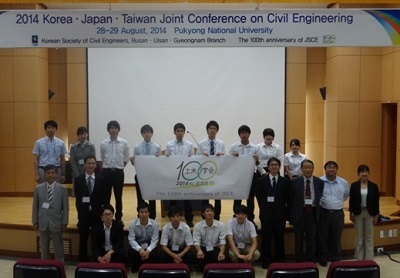 |
| All participants pose for a photo after the conference. |
Brief Summary on 2014 JSCE Annual Meeting-International Program
2014 JSCE Annual Meeting was held at OSAKA University Toyonaka Campus from September 10th to 12th, 2013. during which, the international program hosted by IAC was held.
1.Report on the Sixteenth International Summer Symposium
| The Sixteenth International Summer Symposium was held on September 10, 2014 in Toyonaka Sogo Hall on the Toyonaka campus of Osaka University. The International Summer Symposium is held by the International Students Network Group of the JSCE International Activities Center as part of its activities to support international students. | 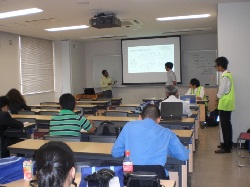 Presentation during the International Summer Symposium Presentation during the International Summer Symposium |
Again this year, it was held as an international portion of the annual academic conference of the Annual Meeting, with the goal of promoting international exchange and mutual understanding by providing opportunities for international students and engineers currently living in Japan to present their research findings in English at the JSCE Annual Meeting. The International Summer Symposium received support from the JSCE International Scientific Exchange Fund, a charitable trust.
This year, 65 papers were presented at a total of 11 international sessions of the academic conference. There were also speeches by three young engineers and students who were visiting Japan on a Study Tour Grant.
In the rooms where the international sessions were held, many audience members participated in lively discussions, and valuable exchanges of information occurred among the participants. Following the International Summer Symposium, an icebreaker session organized by the International Workshop for Young Engineers was held in the evening to celebrate the 100th anniversary of the founding of JSCE. Participants engaged in lively conversations, further promoting international exchange and mutual understanding.
2.Report on the research discussion organized by the International Activities Center at the 2014 JSCE Annual Meeting, on the theme of "What We Learned in Japan: Messages from Leading Civil Engineers Who Have Studied in Japan"
On September 10, 2014, a research discussion organized by the International Activities Center was held at the Center for Education in Liberal Arts and Sciences (CELAS) on the Toyonaka campus of Osaka University, during the 2014 JSCE Annual Meeting, on the theme of "What we learned in Japan: Messages from former international students now working abroad as engineers."
The two engineers who were invited to present topics for this year's research discussion were Lee, Dong-Uk president of the JSCE Korea Section and professor emeritus at Pukyong National University, who was named an honorary member of JSCE this year; and Ko, Wu-Te, secretary general of the JSCE Taiwan Section and assistant professor at Cheng Shiu University, who received the JSCE International Collaboration Award. In their talks, both included comments about their experiences while studying in Japan and advice for current international students. Following the topic presentations, a discussion panel was held with the participation of current international students as well as former international students who are now working in Japan as young engineers.
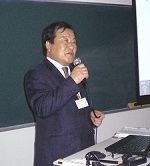 Topic presentation by Dr. Lee |
 Topic presentation by Assist Prof. Ko |
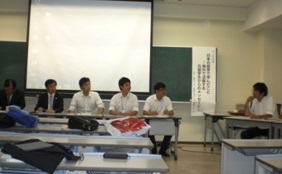 Discussion panel Discussion panel |
3.International Workshop for Young Civil Engineers
The International Workshop for Young Engineers was held by the International Students Network Group, in collaboration with the International Subcommittee of the JSCE 100th Anniversary Executive Committee, at the JSCE Annual Meeting (in Toyonaka, Osaka Prefecture) on September 10–13, 2014. On the theme of "Facing the Challenges of Our Future Society," workshop participants considered future expectations for the year 2050 and discussed the roles of civil engineers in that context and their own roles. A detailed report will appear in the next issue (JSCE International Activities Center News, No. 25).
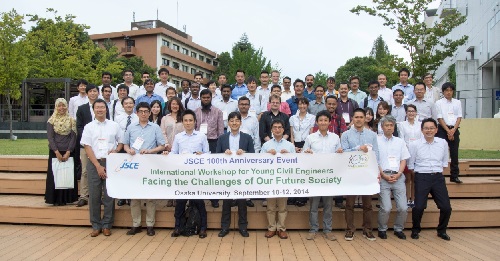 |
| Group photo of workshop participants |
4.Report on the 2014 JSCE Study Tour Grant
Every year, outstanding students and engineers who have been recommended by AOC counterpart societies of other countries are invited by JSCE to visit Japan, with support from the International Scientific Exchange Fund. This year, three visitors – Si Thu Win (Myanmar), Engin Nacaroglu (Turkey), and Ankhbayar Ulziidiidermaa (Mongolia) – visited Japan from September 7 to September 15. They observed construction sites (bridge and road construction for NEXCO East and road construction for NEXCO West), visited research institutes (Public Works Research Institute and Kajima Technical Research Institute), and attended the JSCE Annual Meeting, where they presented at International Summer Symposium. All three seemed to be highly impressed with Japanese civil engineering and expressed an aspiration to learn more about the latest Japanese technologies in the future.
|
Observing construction work on the Shin-Katsushika Bridge of NEXCO East |
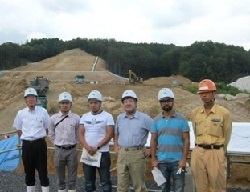 Observing construction work on the Ibaraki-kita Interchange of NEXCO West Observing construction work on the Ibaraki-kita Interchange of NEXCO West |
【The STG Working Group, JSCE International Scientific Exchange Fund Committee】
Kazunori Wada (Ministry of Land, Infrastructure, Transport and Tourism), Hiroshi Takagi (Tokyo Institute of Technology), Yasuyuki Suzuki (CTI Engineering Co., Ltd.), Satoru Kawauchi (Obayashi Corp.), Seizo Ueno (Taisei Corp.), and Hiroyuki Yanagawa (JSCE). (Titles omitted.)
What's Happening
●2014/10/7~11・・・・・ASCE Global Engineering Conference 2014 (Panama City, Panama)
http://content.asce.org/conferences/annual2014/
●2014/10/22~24・・・・・KSCE Annual Meeting 2014 (Daegu-Gwangyeoksi, Korea)
●2014/11/13~15・・・・・PICE Annual Meeting 2014 (City of Legazpi ,Philippines)
≪Topics of JSCE 100th Anniversary Event≫
●2014/11/19・・・・・3rd Round Table Meeting on Disaster Management (JSCE HQ, Tokyo)
http://jsce100.com/node/248
●2014/11/20・・・・・International Forum on “Contributions of Infrastructure to Life of Affluence”
(JP Tower Hal l& Conference, Tokyo) http://jsce100.com/node/249
●2014/11/20・・・・・JAPAN SOCIETY OF CIVIL ENGINEERS 100th Anniversary International Workshop on Sustainability and Resilience of Infrastructures Based on Maintenance and Management Organized By Structural Engineering Committee, JSCE (JSCE HQ, Tokyo) http://www.jsce-int.org/node/289
Updates
●The summary of feature articles in the JSCE Magazine is available on the JSCE website.
http://www.jsce-int.org/pub/magazine
●Concrete Committee International Newsletter No. 38
http://www.jsce.or.jp/committee/concrete/e/newsletter/Newsletter.htm
●Journal of JSCE
The Journal of JSCE is the collection of research papers which can be viewed on the JSCE website.
https://www.jstage.jst.go.jp/browse/journalofjsce
●JSCE 100th Anniversary Postal Stamp was released in September, 2014.
http://jsce100.com/node/250(Japanese Only)
IAC News Subscription
The IAC News is one of the communication tools to share information and ideas with the members. We would like to invite you, your friends and colleagues to join the communication and to subscribe the IAC News. Please register online: (http://www.jsce-int.org/pub/registration/non-international_students). We look forward to meeting you.
Editor's postscript
It has been one month since the large-scale landslide in Hiroshima. Many lives were lost and many residents lost their houses. In 1999, a torrential rail hit some areas in the Hiroshima city and caused over 30 deaths and missions. Soon after that disaster, Sediment-related Disaster Prevention Law was enacted. Responding to that, local municipalities should have conducted surveys and researches on the areas and drawn hazard maps. Aren’t those efforts effective enough to increase residents’ awareness and preparedness of landslides and sediment disasters? Or do the residents believe that they would be safe, and protected by unseen power, I’m wondering.

